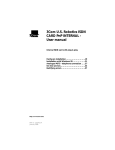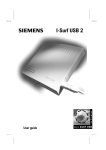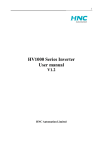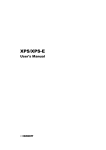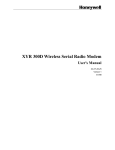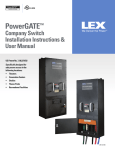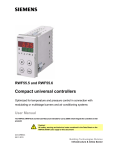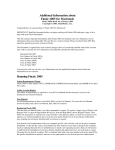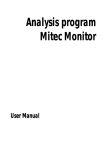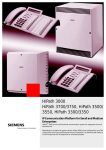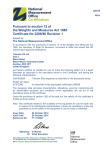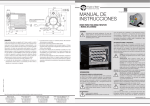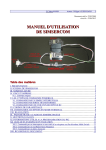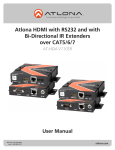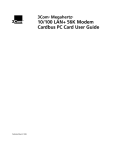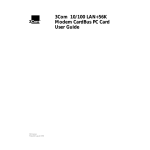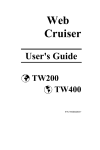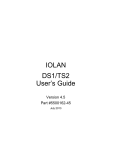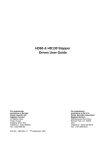Download FP ISDN Technical Manual - Panasonic Electric Works
Transcript
FP- ISDN64k Limitation of liability The present Instruction Manual was compiled with extreme care. The specifications and descriptions given herein are applicable to the FP-Modem 14.4 at the moment of printing. Subsequent designs of the modem as well as the pertinent manuals are subject to changes without prior notice. Matsushita Automation Controls will not accept any liability for damages directly or indirectly arising out of probably existing incorrect statements or omissions in the documentation or discrepancies between modem and manual. Copyright The present publication is protected by copyright. All rights are reserved. Parts of this manual should neither be reproduced in any way by photocopy, microfilm or other techniques nor converted into a form suitable for machines, in particular, for data processing installations without written consent given by Matsushita Automation. Liability assumption for the infringement of patents cannot be derived from the use of information contained in this manual. Trademark V.42bis has been licensed under U.S. Patent 4,558,302. Hayes is a registered trademark of Hayes Microcomputer Products, Inc. 1 02/2008 FP- ISDN64k Table of contents Limitation of liability ................................................................ 1 Copyright................................................................................... 1 Trademark ................................................................................. 1 TABLE OF CONTENTS .........................................................2 A SURVEY .............................................................................4 ISDN – What Is That ? ............................................................... 5 About Digital and Analog Data ............................................ 5 ISDN Modem ........................................................................ 5 S0- Bus: The ISDN Interface at the Subscriber .................... 6 D- and B-Channels: What is Going on at the S0-Port ?........ 6 ISDN Services and Protocols................................................ 6 MSN or EAZ ......................................................................... 7 CAUSE, Error Messages in ISDN ........................................ 8 Communication Methods and Protocols ................................. 8 ASCII Code ........................................................................... 9 Error Correction and Data Compression .............................. 9 Transmission Modes ........................................................... 10 Terminal Adapter Control................................................... 10 Messages ............................................................................. 11 Protocols.............................................................................. 11 LET’S START.......................................................................12 The FP- ISDN 64k..................................................................... 13 Scope of Supplies..................................................................... 13 Connections and Indicators...................................................... 13 Possible Connections to a Matsuhita PLC............................... 14 TOOL Port (programming port) ............................................. 14 COM Port (optional user-programmable communication port)14 The Data Interface of FP- ISDN 64k ...................................... 15 Connection to a Computer (PC).......................................... 15 Connection to COM Port of PLC (Exception FP0) or TOOL Port of FP 10SH .................................................................. 16 Connection to FP0 Controller (COM Port) ........................ 16 Connection to TOOL Port of PLC (FP0, FP-M, FP-C)...... 17 Connection to FP1/FP3 Controller (TOOL Port) ............... 17 2 02/2008 FP- ISDN64k Installation............................................................................... 18 OPERATION OF THE FP-ISDN64K...................................19 AT Commands According To Hayes...................................... 20 Syntax ...................................................................................... 20 The Memories of FP-ISDN64k................................................ 21 Basic Commands For Operation ............................................ 22 Dial Commands .................................................................. 22 Default settings ................................................................... 23 Store Commands................................................................. 24 Sequence Of Data Transmission ............................................. 25 Establishing Connection (Handshaking)............................ 25 Abort Connection ............................................................... 26 Password Protection and Ringback Function ...................... 26 Configure Password and Ringback Function ..................... 26 Report Passwords and Ringback ........................................ 27 Enable/Disable Password/Ringback Function ................... 27 Handshaking upon PW/RR................................................. 27 Leased Line Mode..................................................................... 28 Leased Line Mode Controlled by Terminal Station........... 28 Automatic Leased Line Mode After Power On ................. 28 Advice to the Leased Line Topic ....................................... 29 Other Configuration Commands ........................................ 29 Delete Leased Line Configuration ..................................... 29 Troubles In The Operating Voltage ....................................... 29 FP-ISDN64k Messages ............................................................. 30 AT- COMMAND SET SUMMERY ........................................34 THE FUNCTION OF S-REGISTERS ...................................40 TECHNICAL DATA AND CERTIFICATION .......................45 Factory Default Settings .......................................................... 46 Certification ............................................................................. 47 S0 Standard Connection RJ12-RJ45 ........................................ 47 Modem Specifications ............................................................. 48 ISDN Error Messages (CAUSE) ............................................. 49 Technical Terms ...................................................................... 51 3 02/2008 FP- ISDN64k 1 A Survey This section of the Instruction Manual was particularly written for beginners and deals with the fundamental mode of function of ISDN, of an ISDN connection and of the terminal adapter FPISDN64k. 4 02/2008 FP- ISDN64k ISDN – What Is That ? About Digital and Analog Data Within a computer or a PLC, the data are transmitted in digital form between the individual components (processor, I/O units, storage medium etc.) and processed. Digital means transmission by electrical pulses which may take two states, either ON or OFF (HIGH or LOW, ONE or ZERO). These signals show a constant amplitude, mostly amounting to 0 volts in OFF state and 5 volts in ON state. They are called BITS and represent the smallest units of a digital signal. These bits can be transmitted and processed either individually one following the other or gathered in groups (for instance, 8 bits of one group are called BYTE). In the first instance, serial processing and, in the other instance, parallel processing are concerned. The most widespreadly known transmission medium for signals, namely the telecommunication network, has been established for the transmission of language i.e. of analog data. If one intends now to transmit the information required for modern data processing in computers through this network, the data shall be converted for this purpose. The modem is exactly this converter and represents the link between the digital environment of computer and the analog environment of the telecommunication network. A modem is a device for performing the conversion of digital signals into analog signals and vice versa. Modem is an abbreviation and means MOdulator-DEModulator. The digital data signal is modulated on an analog carrier and demodulated again in the receiver. The method of modulation has to be selected so that as much data as possible can be transmitted without exiting the frequency range predefined by the transmission channel (telephone line). Exchange of information has to be ensured without any losses. ISDN Modem Since the telecommunication network has been increasingly extended and converted in a digital way, the subscriber should also have the possibility of a digital connection offered. To this end, a special exchange standard was developed i.e. the ISDN. All 5 02/2008 FP- ISDN64k information will be transmitted there digitally. If an analog subscriber calls a digital one or vice versa, the analog signals are converted into digital data at the exchange (digital/analog conversion). If a subscriber has got a digital ISDN connection, it is not possible without more ado to connect an “obsolete” analog terminal unit, for instance, a modem (with an additional device only). Since, however, computers and PLC systems etc. need a modem for communication, special ISDN modems have been developed, so-called terminal adapters. These terminal adapters function with the terminal unit as compared to their brothers, however, they must not convert the user data for transmission into analog data but are processing them digitally in the transmission protocol selected. S0- Bus: The ISDN Interface at the Subscriber The ISDN network is connected to the subscriber through an NTBA. A basic connection with a so-called S0-interface is made available on this device. The terminal units, such as ISDN phone or ISDN terminal adapter are connected to this S0-port. When several connection outlets are installed alongwith the NTBA, this port is called S0-bus. This bus is comprised of 4 lines, two for transmitting data and two for receiving data. As compared to an analog connection, this bus cannot be extended as you like. The wires should not be interchanged in the wiring and matching resistors shall be provided at the bus terminations. D- and B-Channels: What is Going on at the S0-Port ? 1 D-channel and 2 B-channels are made available to the subscriber at a basic connection port. The D-channel has a data throughput rate of 16,000 bps and the B-channel of 64,000 bps. ISDN protocols were defined to make use of these channels. Whereas the protocol in D-channel ensures exchange of information required for a connection between terminal unit and exchange offices, the protocols in B-channel are responsible for mutual communication between the terminal units involved in the connection. ISDN Services and Protocols The D-channel protocol DSS1 (EURO-ISDN) or 1 TR6 (old ISDN standard of Telekom) is split up into 3 layers. In the D-channel, among others, the connection port is checked, the telephone 6 02/2008 FP- ISDN64k number, the own connection number and the desired ISDN service are exchanged in the B-channel between exchange office and terminal unit, however, user data are not transmitted ! The following ISDN services are available: ISDN service Who needs this service? 3.1 kHz Audio transmission ISDN phones and all analog units connected to an S0 via additional hardware (A/D converter) Data transmission 64,000 bps ISDN-PC boards, all terminal units for data transmission and FP-ISDN64k Telefax group 4 ISDN facsimile machine with 64,000 bps X.31 Data transmission in D-channel, to be ordered separately Notice ! A transition of services from data transmission at 64,000 bps to audio transmission at 3.1 kHz is not possible. Therefore, a phone cannot be called with a terminal adapter to test the installation, that is, communication between ISDN data terminal units is only possible ! The B-channels can be simultaneously operated separately from each other with various services. Coordination of B-channels is effected by the D-channel. In the data service at 64,000 bps, other protocols are available for data transmission which are also supported by FP-ISDN 64k: X.75, X75-T.70NL, V.110, BTX, HDLC. For data transmission, the B-channels can be grouped to achieve a higher data throughput rate (2x64,000 bps). MSN or EAZ Three different phone numbers can be allocated to one EUROISDN main connection. If several terminal units of the same service identifier code (e.g. 64,000 bps/data) are connected to one connection port, but each unit has to be accessible, each unit shall get another phone number, also called MSN. As to the elder 1 TR6 ISDN model, there is only the possibility to indicate the last cipher of phone number as distinctive feature (0-9). In the 1 TR6 protocol, this cipher is named EAZ. 7 02/2008 FP- ISDN64k CAUSE, Error Messages in ISDN The ISDN offers quite a number of error messages also evaluated by the FP-ISDN 64k and output to the terminal unit. If a subscriber to be called-up is busy, no busy tone is sent by the exchange, but the error message 0x34B5 is transmitted in the D-channel. The terminal adapter can then output the BUSY message to the terminal unit. Since suitable message codes are not available for all ISDN error messages, the CAUSE errors can be visualised by means of the “AT%Y1” command (survey on page 49). Communication Methods and Protocols The data flow processed by the ISDN modem is comprised of two different components. On the terminal unit side to the controller (computer, PLC ...) either data or control commands for the ISDN modem are being transmitted. In the ISDN part to the telecommunication network, a high data throughput has to be achieved and occurring errors have to be corrected. Various methods and protocols are applied to this end. The transmission rate is mainly dependent on the rate between terminal unit and ISDN modem. On the transmission side in the ISDN network, always one B-channel is assigned to 64,000 bps. The following ISDN standards are supported by FP-ISDN64k: • 64,000 bps transparent – full duplex, without data backup or data compression protocol • X.75 – full duplex, with data backup • X.75-T.70NL- same as X.75, with additional network protocol • V.110 – full duplex, 300 to 56,000 bps, without data backup, only standardised from 1,200 to 9,600 bps, asynchronous transmission • HDLC – data transmission protocol • PPP/SLP – transmission protocol for TCP/IP networks (e.g. Internet), working on HDLC connections 8 02/2008 FP- ISDN64k ASCII Code During data transmission through a terminal adapter, a definite combination of 8 bits is used to represent individual characters. This standard developed over many years is called ASCII code. The original ASCII table contains 128 characters only (letters, ciphers, special characters) and could also be represented by a group of 7 bits instead of 8 bits: the most significant bit is always 0. In the ASCII representation, this eighth bit is superfluous, however, it is generally transmitted since the computer is processing the data internally on an 8-bit basis (BYTE). When using your modem, you might ascertain that there is a possibility of choice between 7 bits or 8 bits ASCII in some transmission modes. Error Correction and Data Compression During transmission, errors may occur due to interference noise or to distortion of digital signals. To ensure high data safety, the data are incorporated in an error protocol, that is, information will be added to the actual data enabling the receiver modem to detect errors and to correct them, if necessary. On exchange side, such ISDN standards as X.75 or HDLC are being applied. The standard V.42 LAPM and MNP2-4 correction methods can also be used between two terminal adapters. If the V.42 mode has been activated, the terminal adapter transmits a definite character string to detect which configuration is enabled by the remote station and then selects LAPM or MNP according to the requirements. By means of the FP-ISDN64k, you have also the possibility to enforce a connection under MNP or LAPM, provided that one of the two correction modes is supported. In order to transmit still more data per time unit, the data flow can be additionally compressed. V.42bis and MNP5 re used as relevant methods. In dependence on the type of data to be transmitted, the rate can be partially more than triplicated. The FP-ISDN64k is configuring itself during the establishment of connection in dependence on the preset transmission mode and adjusts the methods possible with the remote station. 9 02/2008 FP- ISDN64k Transmission Modes Nine different modes can be adjusted for data transmission through ISDN network: • DIRECT mode: Transmitted / received data buffer disabled, transmission rate to the controller is matched with the connection speed, no error correction, no data compression • NORMAL mode: Transmitted / received data buffer, no error correction, no data compression • RELIABLE mode: Transmitted / received data buffer, functions only with error correction either according to LAPM or MNP2-4, the terminal adapter hangs up if the remote modem does not admit of an error correction, data compression according to V.42bis or MNP5 is possible • AUTO-RELIABLE mode: Transmitted / received data buffer, automatic selection of the error correction method according to V.42 or MNP, if the remote modem does not admit of an error correction, NORMAL mode is applied, data compression according to V.42bis or MNP 5 is possible • In addition, the ISDN protocols already described, such as X.75, are available. Terminal Adapter Control Interfacing with the controller (computer or PLC) also often called DTE (Data Transmission Equipment) is effected through a serial asynchronous RS232 interface. Adjustment of the interface parameters, such as rate and number of the data and control bits, is made automatically in the terminal adapter in accordance with the standard parameters preset by the controller. The control of terminal adapter follows the AT-Hayes command set. The commands are transmitted from the controller to the terminal adapter in form of ASCII data. These commands can be sent from a control program or entered manually via terminal program. Basic configurations have been stored in the terminal adapter which make possible instant use without any configuration. The dial commands only shall be sent to the modem from the controller. 10 02/2008 FP- ISDN64k If an adaption to various operating conditions is required, the operating parameters of the terminal adapter can be adjusted and saved by means of the AT commands. Messages In responding to the control commands and upon errors occurred, the terminal adapter generates messages enabling the controller to check the execution of commands and to supervise the operating state. These messages are sent in ASCII format as text or as ciphers. Protocols The term “Protocol” combines quite a number of rules defining the characteristics of the data signals for transmission. During the communication between two computers, both computers shall function according to a uniform protocol to ensure correct interpretation of the signals communicated. The protocols are an integral part of the computers’ communication software. A protocol featuring enhanced data safety is Z-MODEM. 11 02/2008 FP- ISDN64k 2 Let’s Start In this section, you will find general information about the installation of FP-ISDN64k. Please study these instructions carefully prior to putting into operation. 12 02/2008 FP- ISDN64k The FP- ISDN 64k The FP-ISDN 64k supports communication and data exchange with other computers/controllers through the ISDN network. The terminal adapter is operated with the standard commands according to Hayes and can be easily adapted to the respective system. Scope of Supplies The scope of supplies of the terminal adapter includes: • • • FP-ISDN 64k Telephone connection cord RJ12 to RJ45 User manual If one of these items is found defective or is completely missing, please raise claims immediately. Connections and Indicators Fig. 1: Front view of FP-ISDN 64k 1 2 3 4 S0 connection jack (RJ12) for dial and leased line, assignment of cable, see page 47 LED DCD - Data Carrier Detect, is lighting upon established data communication, LED extinguishes after Power On after approx. 1 second LED Power / Test – is lighting upon operating voltage applied, when this LED remains OFF or is flashing after Power On, the modem is defective and has to be replaced Jack BU1 for operating voltage +24VDC, the GND pins are linked internally ATTENTION: Note polarity. 13 02/2008 FP- ISDN64k Possible Connections to a Matsuhita PLC You may connect the FP-ISDN64k either to the “TOOL Port” (programming port) or to the “COM Port” (optional second userprogrammable communication port). TOOL Port (programming port) Upon connection to the TOOL port, the modem interfacing shall be adjusted in the system register 411 of PLC (see Programming Software Manual). Then, the terminal adapter is automatically initialised by the PLC by setting the FP-ISDN64k register S0 = 1. The terminal adapter then receives arriving calls automatically so that you may have access to the PLC after establishment of connection from the remote PC (or any other controller). How to protect your PLC from unauthorised access, please read section Password Protection and Ringback Function on page 26. For maximum safety (access protection “on-site”), you may also store a password in the PLC. COM Port (optional user-programmable communication port) The second additional RS232C port of the PLC also makes available the function described above. In addition, this port is userprogrammable, that is, you may transmit and receive any data in any format and even switch-over between both modes during operation. The following shall apply in general: a) If the PLC is to establish an active connection by itself, you have to connect the FP-ISDN64k to the additional COM port (communication port). b) Suffice it to wait for a call, you may connect the terminal adapter to both ports. After establishment of connection, you will have full access to the PLC in both cases, that is, you may either read or write data. 14 02/2008 FP- ISDN64k The Data Interface of FP- ISDN 64k The connections of serial interface comply with the V.24 standard with V.28 level. The following signals are used: 1- RxD, is the received data line at FPISDN64k and shall be connected to RxD of the PLC 2- GND (signal ground) 3- TxD, is the transmitted data line at FPISDN64k and shall be connected to TxD of the PLC 5 Jack BU 2 – serial interface for interfacing with the controller (computer / PLC) Fig. 2: Bottom of the device Connection to a Computer (PC) Assignment of a connection cord between FP-ISDN64k and PC (V.24/V.28 or RS232C Sub-D 9-pin female connector) Fig. 3: Connection cord for PC 15 02/2008 FP- ISDN64k Connection to COM Port of PLC (Exception FP0) or TOOL Port of FP 10SH Assignment of connection cord between FP-ISDN64k and PLC, (RS232C Sub-D 9-pin male connector) Fig. 4: Connection cord to PLC Connection to FP0 Controller (COM Port) Fig. 5: Connection cord to FP0 COM Port 16 02/2008 FP- ISDN64k Connection to TOOL Port of PLC (FP0, FP-M, FP-C) Assignment of connection cord between FP-ISDN64k and TOOL Port of above FP controllers (RS232C miniature DIN 5-pin male connector) Fig. 6: Connection cord to TOOL Port Connection to FP1/FP3 Controller (TOOL Port) Assignment of connection cord between FP-ISDN64k and FP1/FP3 cable (TOOL Port ↔ PC) (RS232C Sub-D 25-pin male connector) Fig.7: Connection cord to TOOL Port 17 02/2008 FP- ISDN64k Installation The FP-ISDN64k has been conceived, among others, for use on DIN rails of 35 mm (top-hat rail). For installation, please proceed as follows: • • • • Install terminal adapter and PLC on the top-hat rail Connect the data lines (jack BU2) to the PLC and the telephone cord to the S0 outlet Connect the terminal adapter to the 24V DC operating voltage (jack BU1). Switch-on the power supply unit. After switching-on the device, the LED „POWER/Test“ for selftest extinguishes after approx. 2 seconds. After successful Power On self-test, the LED „POWER/Test“ is lighting permanently. In case of a flashing or dark LED „Test“, the terminal adapter is defective and has to be replaced. 18 02/2008 FP- ISDN64k 3 Operation of the FP-ISDN64k In this section, the use of AT commands and registers is described and the basic commands are introduced. The sequence of a data transmission is explained, too. 19 02/2008 FP- ISDN64k AT Commands According To Hayes The terminal adapter FP-ISDN64k is operated from the controller (computer, PLC, ...) by means of the AT commands according to Hayes standard regardless of the fact whether these commands are transmitted from a control program or from a terminal program by manual input. The terminal adapter is in the command mode reached after switching-on and ending a connection. The terminal unit rate is detected automatically up to a rate of 57,600 bps and a data format of 8 data bits, with no parity and 1 stop bit (8N1). After establishment of connection, automatic changeover to data mode is effected. With the Escape command +++, you may go from this mode to command mode. Return to data mode is possible with ATO. The commands are sent in ASCII code. A complete list of available commands is given in section “AT Commands Summary”. For reasons of compatibility, commands are included that can be executed, however, do not have any effects, such as e.g. AT M..., AT L...(no speaker) and AT DT...(no tone dialing possible in ISDN). Most settings are stored in the terminal adapter so that the command sequences are restricted to a minimum extent in normal mode (telephone number or memory location of telephone number). If the changes which you make by the input of AT commands adversely affect the functionality of your FP-ISDN64k, you can reload the factory default settings with ATCLEAR. Syntax All Hayes commands begin with the ASCII character AT (English abbreviation for: Attention). These characters are parsed by the terminal adapter, decoding the command flow. The data format should be 8 data bits, no parity, 1 stop bit (other formats are adjusted through the S-registers S60/S61). The terminal adapter interprets all successive characters as commands. After an AT, several commands (max. 58 characters) can be grouped together in a sequence. The input is terminated with Return/Enter and the control sequence is then sent to the terminal adapter. 20 02/2008 FP- ISDN64k The terminal adapter confirms with "OK" or with the respective value in case of queries. If the instruction could not be executed, the message "ERROR" is output. The AT commands can be entered either in upper case or lower case, however, not in a combination of both cases. Erroneous inputs can be deleted with the backspace key. The AT characters at the beginning of the line cannot be deleted. The Memories of FP-ISDN64k The FP-ISDN64k has got different memories to save programs and data to maintain its functionality. On the one hand, the contents of these memories are partially fixed-programmed, on the other hand, they can be edited by AT commands for individual adaption of the terminal adapter. The alterable data are contained in the S-registers. One can distinguish between three memory levels: Program memory ROM AT&F0 → AT&F1 → Main memory RAM AT&Wn → ← ATZn Power on: ← AT&Yn User memory EEPROM The Program Memory in which the overall sequence of functions and the preset data of the FP-ISDN64k have been stored is a ROM (Read Only Memory) that can be read only. To load the default settings, enter command AT&F3, to erase all memory areas, enter ATCLEAR and then wait approx. 2 seconds. All settings in the unit are deleted by means of this command ! The User Memory in which the data of the S-registers (profile 0 and profile 1) modified by the user have been stored is an EEPROM (Electrically Erasable Programmable ROM). This memory can be written and will save the data even after disabling of the FP-ISDN64k. After you have edited the contents of Sregisters, they are written in the user memory by AT&Wn. By means of the AT&Yn command, you may define which of both the settings shall be selected for use when enabling the FP-ISDN64k. By means of ATZn, you may release a software RESET and load the profile(n). 21 02/2008 FP- ISDN64k Furthermore, telephone numbers can be stored in the user memory by means of the AT&Z(n)=x command, whereby x may have a length of up to 15 characters. The Main Memory of the FP-ISDN64k is a fast write/read memory of the RAM type (Random Access Memory) that is used during operation. After enable, a RESET or ATZn, data are loaded from the user memory or the data of default settings are loaded by means of AT&F3. By means of the AT&V command, the active configuration (in main memory) and, by means of the AT\S command, the most essential settings with prompt texts can be reported. Basic Commands For Operation The following commands are the basis for operation and will generally suffice. A part thereof can be saved in the user memory so that the sequences of operation are restricted to a few commands only. The AT preceding the commands was omitted in the tables. When the FP-ISDN64k is in data mode, toggling to command mode is possible with the Escape sequence +++ (without AT !!). For return to data mode, ATO is sent. Dial Commands ATDn is the general dial command that can be modified with the n options. D DP DT D, Dial command Pulse dialing; ignored in ISDN Tone dialing; ignored in ISDN Dial pause, the time is specified by S8 register, then, the dialing cycle is resumed DW Wait for dial tome; ignored in ISDN DSx Dials the number stored in the directory, x stands for shortcode dial number, for instance: ATDS1 dials the number stored by AT&Z1 DL Re-dial last number D0-D9 Dials reported ciphers, *,#,A,D possible upon tone dialing D...; Semicolon at the end of number, modem goes to command state after establishment of connection (same as +++) 22 02/2008 FP- ISDN64k H Interrupts a current connection, the modem goes "on-hook" Default settings S99=0 Definition of ISDN-D-channel protocol to DSS1 (EUROISDN) %Z=n Probable definition of an MSN number at DSS1 (see page 7) S99=1 Definition of ISDN-D-channel protocol to 1 TR6 (old national standard) S96=n Probable definition of an EAZ number at 1 TR6 (see page 7) F70\N6 Selects B-channel X.75 with data backup duplex F64 Select B-channel V.110 with 9,600 bps duplex Xn See tables FP-ISDN64k Messages as from page 30 F255 Select auto-detect mode for B-channel F60 Select B-channel V.110 with 300 bps duplex F61 Select B-channel V.110 with 1,200 bps duplex F62 Select B-channel V.110 with 2,400 bps duplex F63 Select B-channel V.110 with 4,800 bps duplex F64 Select B-channel V.110 with 9,600 bps duplex F65 Select B-channel V.110 with 19,200 bps duplex F66 Select B-channel V.110 with 38,400 bps duplex, not standardised F67 Select B-channel V.110 with 48,000 bps duplex, not standardised F68 Select B-channel V.110 with 56,000 bps duplex, not standardised F70 Select B-channel with 64,000 bps duplex, used for X.75 (AT\N6) \N0 Select NORMAL mode: no error correction, no data compression \N1 Select DIRECT mode: interface port rate is matched with transmission rate, no error correction, no data compression, required for V.110 \N2 Select AUTO-RELIABLE mode: terminal adapter hangs up if the remote modem does not admit of an error correction, error correction first according to LAPM and then to MNP, data compression according to V.42bis or MNP5 possible (AT%Cn) 23 02/2008 FP- ISDN64k \N3 \N4 \N5 \N6 Q0 Q1 V0 V1 Select AUTO-RELIABLE mode: operation in NORMAL mode when the remote modem does not admit of an error correction, error correction method according to V.42 or MNP, data compression according to V.42bis or MNP5 possible (AT%Cn) Select RELIABLE mode: error correction according to LAPM only, otherwise, terminal adapter hangs-up, data compression according to V.42 possible (AT%Cn) Select RELIABLE mode: error correction according to MNP only, otherwise, terminal adapter hangs-up, data compression according to MNP5 possible (AT%Cn) Select X.75: most commonly used ISDN protocol (transmission method in B-channel to ATF70) Modem messages are sent Modem messages are suppressed Modem messages are output numerically (terse) Modem messages are output as text (verbose) Store Commands Sn Sn? Sn=x &F3 &V Selects register with the number n Reports the value of register with the number n Sets register with the number n to value x Factory default configuration loaded from database3 Reports settings of current and two user-defined configurations. The first four stored telephone numbers are reported additionally &W0 Stores the current configuration in user profile 0 &W1 Stores the current configuration in user profile 1 &Y0 After RESET or upon power-up of modem, the configuration of user profile 0 will be used &Y1 After RESET or upon power-up of modem, the configuration of user profile 1 will be used &Zn=x Stores 20 telephone numbers (n=0...3), x max. 34 characters Z0 Releases software RESET (warm RESET) and restores the configuration of user profile 0 Z1 Releases software RESET (warm RESET) and restores the 24 02/2008 FP- ISDN64k configuration of user profile 1 Sequence Of Data Transmission Controller and terminal adapter are ready to operate. The telephone connection cord has been linked with the ISDN socket outlet. The sequence will be explained for connection to a subscriber’s station. Establishing Connection (Handshaking) Typical dial command for an analog modem: The controller sends ATDT0W 0999 12345 <CR> to the modem. AT initiate command DT – dial with tone dialing 0W – subscriber’s station gets an exchange 0999 12345 – target telephone number <CR> - terminate command This dial command can also be used for the FP-ISDN64k. The commands “T” (tone dialing) and “W” (wait for exchange) do not exist in ISDN. They are simply ignored by the terminal adapter. The FP-ISDN64k starts dialing. After the subscriber’s station goes off-hook, the handshaking protocol is run between the two terminal adapters. The used protocols are declared therein. If the connection was established successfully, the terminal adapter reports to the controller the line speed and the type of error protocol used. Then, the terminal adapter gioes to data mode. The DCD-LED starts lighting. In data mode, the FP-ISDN64k transmits information to be exchanged directly from the controller to the remote terminal adapter or vice versa. The data connection cannot be established if the two devices cannot detect a transmission method that can be used by both or if extremely severe interferences occur. The FP-ISDN64k responds with NO ANSWER. If the DTE sends characters during the connection phase, the modem goes on-hook and responds with NO CARRIER. When the FP-ISDN64k is called, it will send the ASCII RING string to the controller at every ring. If a number higher than zero has been adjusted in the S0 register, the FP-ISDN64k goes off-hook 25 02/2008 FP- ISDN64k after expiration of this number of rings. Now, the handshaking protocol commences, as described above. With S0=0, the FP-ISDN64k remains in inactive state. Abort Connection The data connection is maintained until the FP-ISDN64k • • • • • has got the command for on-hook (+++ ATH) from the controller, response NO CARRIER the exchange interrupts the connection (too severe interferences, remote station not active any more, ...), response NO CARRIER a BUSY signal (busy tone) has been detected, response BUSY has got an abort sequence from the remote terminal adapter, response NO CARRIER causes for abort or errors are reported in the ISDN by CAUSE messages (survey in annex on page 49) Password Protection and Ringback Function To protect the controller linked with the FP-ISDN64k and the data saved therein from unauthorised access, you can install an access and user check by means of the Password/Ringback Function (PW/RR). Two levels of safety are possible: Level 1: Level 2: Access only with valid password Access only with valid password and ringback to the stored number 20 storage locations are available for PW/RR in which a combination of both levels can be used, too. Configure Password and Ringback Function First define the master password by means of which the PW/RR function can be enabled/disabled. The master password is defined in the short-code dial register Z0 (do not forget the “/” character before the PW). Example: AT&Z0=/MASTER 26 02/2008 FP- ISDN64k Hereunder you may define your access passwords and, if required, the ringback numbers in the short-code dial registers Z1-Z19. If no ringback function has to be allocated, the ringback number before the password shall be omitted. Example without ringback: AT&Z1=/SECRET Example with ringback: AT&Z2=0123456/GEIGE In both cases, do not forget the separator character “/” before the PW. Report Passwords and Ringback AT&Z? all passwords and ringback numbers are reported (with PW/RR function disabled only). Enable/Disable Password/Ringback Function The password/ringback function is disabled in state of delivery. This function can be enabled by the following change to be made. AT%M1/MASTERPASSWORD The master password is the PW defined in the short-code dial register Z0, in our example, “/MASTER“. PW/RR can be disabled with the following command: AT%M0/MASTERPASSWORD Handshaking upon PW/RR The FP-ISDN64k protected with password is called (S0 register shall be set to 1 ... 5 !). After handshaking, the message CONNECT and the prompt “ENTER PASSWORD:” will appear on the monitor of computer. If the password has been correctly entered and acknowledged with ENTER, the protected FP-ISDN64k goes to data mode and communication is made possible. When using the ringback function, too, the FP-ISDN64k goes onhook after successful input of password and will call the pertinent telephone number in the next few seconds. After handshaking completed, the FP-ISDN64k goes immediately to data mode and communication is made possible. When entering a false password, the input can be still repeated up 27 02/2008 FP- ISDN64k to three times. If this is also not successful, the FP-ISDN64k goes on-hook. Leased Line Mode The FP-ISDN64k has been permitted for leased line mode on lines of the type Müw 6 Type B (or 1TR805 Part 6B). This is a costeffective leased line with a configured 64,000 bps B-channel without D-channel (64S, Group 0 Type 4). There are two possibilities to enable leased line mode: 1. The terminal station (PC, PLC, controller etc.) connects the FPISDN64k to the leased line. This is done by means of AT commands. 2. The FP-ISDN64k is configured in the forefront, for instance, with a terminal program so that it will go to leased line automatically after the operating voltage has been applied. Leased Line Mode Controlled by Terminal Station In this mode, the FP-ISDN64k goes to leased line mode by means of the following commands: Modem 1 (Master): AT&L1D <ENTER> Modem 2 (Slave): AT&L1A <ENTER> This mode has the disadvantage that both terminal adapters have to be enabled in this way at the same time. The duration of the maximum handshaking time is controlled by register “S7” (defined to 100 sec.) When the terminal adapters are enabled with a longer time delay, no connection will be established. After unsuccessful attempt to establish the connection, fallback to leased line mode has to be initiated again by the terminal station. Automatic Leased Line Mode After Power On In automatic leased line mode, the FP-ISDN64k goes on-line after the Power On self-test and attempts to establish the connection with the remote modem. It remains active even if the remote terminal adapter has not yet been ready. For automatic leased line mode, the FP-ISDN64k shall be configured as follows: 28 02/2008 FP- ISDN64k Modem 1 (Master): AT&L2&D0<ENTER> Modem 2 (Slave): AT&L3&D0<ENTER> These configurations shall be saved with „AT&W<ENTER>“ and are enabled after „ATZ“ or after Power ON. Advice to the Leased Line Topic Other Configuration Commands When the leased line application shall function, for instance, at 9,600 bps, the terminal program/PC used for configuration of the modem has also to be adjusted to 9,600 bps at the COM Port. Due to the AT commands entered, the FP-ISDN64k detects automatically the transmission rate and will save it. - Fixed adjustment of ISDN protocol e.g.: ATF70<ENTER> (fix 64,000 bps) - Fixed adjustment of DTE rate e.g. ATS51=7 (9,600 bps) - If required, insist on an error-safe connection, AT\N4<ENTER> - Check data format (def. 1 start bit, 8 data bits, no parity, 1 stop bit) - Save commands with AT&W<ENTER> Delete Leased Line Configuration Interrupt the leased line, then, enter the following commands: AT<ENTER> AT&F&W<ENTER> ATZ<ENTER> or Power OFF/ON Troubles In The Operating Voltage The range of operating voltages in which the modem functions safely is +/-10%. When falling below this limit, a RESET is released in the modem maintained until recovery of voltage. So, malfunctions due to too small operating voltages are excluded. In this case and upon total breakdown of operating voltage, the 29 02/2008 FP- ISDN64k modem goes on-hook. Data transmission shall be repeated after recovery of the operating state. Exceeding beyond the limit of the range of operating voltages may cause destruction of the modem and shall be avoided at any rate. FP-ISDN64k Messages The scope and the type of messages of the FP-ISDN64k can be adjusted by means of the ATVn and ATXn commands. The messages described below are output by the modem if the ATX command is in the ATX4 presetting. The numerical format is set with ATV0 and the text format with ATV1. Upon error messages during handshaking, additional indication of the ISDN Cause value is probably helpful for troubleshooting AT%Y1. Message Long-form (text) Meaning Shortform OK 0 Faultfree execution of the last command entered CONNECT 1 Handshaking successful, data connection has been established RING 2 The FP-ISDN64k detects an incoming call, each ringing is reported on the monitor with "RING" until the connection has been established or aborted NO CARRIER 3 The exchange has released the connection (if required, set AT%Y1) ERROR 2 possible causes 4 1. The last command entered could not be executed faultfree 2. The command line contained too much characters NO DIALTONE 6 The FP-ISDN64k could not establish a connection to the exchange ⇒ error at S0 connection, check ! 30 02/2008 FP- ISDN64k ABORT 15 Error at S0 connection, check ! BUSY 7 The dialed subscriber is busy. NO ANSWER 8 No subscriber answers under the dialed number with a 64,000 bps data service permit CONNECT XXX The FP-ISDN64k has successfully established a connection, if ATW0 has been adjusted, the interface speed to the PC will be reported in bps, if ATW2 has been adjusted, the line speed will be reported in bps (see table All Modem Messages) Any possible modem messages in association with the „ATXn“ command: Shortform n- parameters of ATXn command Long-form 0 1 2 3 4 X X X X X 0 OK 1 CONNECT X X X X X 2 RING X X X X X 3 NO CARRIER X X X X X 4 ERROR X X X X X 5 CONNECT 1200 1 X X X X 6 NO DIALTONE 3 3 X X X 7 BUSY 3 3 3 X X 8 NO ANSWER X X X X X 10 CONNECT 2400 1 X X X X 15 ABORT 4 X X X X 30 CONNECT 9600 1 X X X X 31 CONNECT 4800 1 X X X X 31 02/2008 FP- ISDN64k Shortform n- parameters of ATXn command Long-form 32 CONNECT 7200 1 X X X X 33 CONNECT 12000 1 X X X X 34 CONNECT 14400 1 X X X X 35 CONNECT 16800 1 X X X X 36 CONNECT 19200 1 X X X X 37 CONNECT 75/1200 1 X X X X 38 CONNECT 1200/75 1 X X X X 50 CONNECT 300/REL 1 X X X X 51 CONNECT 1200/REL 1 X X X X 52 CONNECT 2400/REL 1 10 X X X 53 CONNECT 9600/REL 1 32 X X X 54 CONNECT 4800/REL 1 31 X X X 59 CONNECT 19200/REL 1 36 X X X 60 CONNECT 38400/REL 1 94 X X X 61 CONNECT 57600/REL 1 95 X X X 70 CONNECT 300/COMP 1 1 50 X X 71 CONNECT 1200/COMP 1 5 51 X X 72 CONNECT 2400/COMP 1 10 52 X X 73 CONNECT 9600/COMP 1 30 53 X X 79 CONNECT 19200/COMP 1 36 59 X X 70 CONNECT 38400/COPM 1 94 60 X X 81 CONNECT 57600/COMP 1 95 61 X X 94 CONNECT 38400 1 X X X X 95 CONNECT 57600 1 X X X X 102 CONNECT 64000 1 X X X X 122 CONNECT 64000/REL 1 102 X X X 32 02/2008 FP- ISDN64k Shortform n- parameters of ATXn command Long-form 142 CONNECT 64000/COMP 1 102 142 X X 144 CONNECT 115200/COMP 1 104 124 X X /REL means that an error-safe connection has been established /COMP means that a connection with data compression (MNP5 or V.42bis) has been established 33 02/2008 FP- ISDN64k 4 AT- command set summery List of the available AT- commands and their functions. 34 02/2008 FP- ISDN64k All commands begin with characters AT, for example ATA for command A ! Command Function A Go off-hook and attempt to answer a call CLEAR Main RERSET, clear all settings Dn Dial modifier, n-values: P Force pulse dialing (see p. 11) T Force DTMF dialing (see p.11) , Dial pause, the time is specified by S8-register W Wait for dial tone, the time specified by S6-register @ Wait for silence ; Return to command state S=n Dial the number stored in the directory (n = 0 to 3) A-D*# DTMF digits L Re-dial last number E0 Turn off command echo E1 Turn on command echo F255 Select auto-detect mode for B-channel F60 Select B-channel V.110 with 300 bit/s duplex F61 Select B-channel V.110 with 1.200 bit/s duplex F62 Select B-channel V.110 with 2.400 bit/s duplex F63 Select B-channel V.110 with 4.800 bit/s duplex F64 Select B-channel V.110 with 9.600 bit/s duplex F65 Select B-channel V.110 with19.200 bit/s duplex F66 Select B-channel V.110 with 38.400 bit/s duplex F67 Select B-channel V.110 with 48.000 bit/s duplex F68 Select B-channel V.110 with 56.000 bit/s duplex F70 Select B-channel X.75 with 64.000 bit/s duplex (AT\N6) H Initiate a hang-up sequence, modem go on-hook I0 Report software version I1 Report V.42/MNP software version I10 Report specific data of device I11 Report status of last connection I12 Report status of charge, 0= free, 1= chargeable L0 Set low speaker volume L1 Set low speaker volume L2 Set medium speaker volume L3 Set high speaker volume 35 02/2008 FP- ISDN64k M0 M1 M2 M3 O0 O1 Q0 Q1 Sn? Sn=v V0 V1 X0 X1 X2 X3 X4 Zn &B1 &C0 &C1 &C2 &D0 &F3 &H0 &H1 &I0 &I1 &I2 &L0 &L1 &L1 &L3 &M0 &R0 &R1 &R2 &S0 Turn speaker off Turn speaker on during handshaking Turn speaker on if modem is OFF HOOK Turn speaker on till handshaking Go data-mode Go data-mode and initiate a retrain sequence Allow result codes to DTE Inhibit result codes to DTE Reports the value of S-Register n Set S-Register n to value v Report short form (terse) result codes Report long form (verbose) result codes Report result codes 0 to 4 only busy and dial ton Report result codes 0 to 38 and 90 to104 Report result codes 0 to 65 and 90 to124 Report result codes 0 to 144 Report all result codes with protocol/COMP/V.42bis Restore stored profile n after warm reset. Turn command phase off DCD remains ON at all times DCD follows the state of the carrier DCD remains ON in the transparent mode The modem ignores DTR (Do not change!) Restore factory configuration 3 from EPROM disable simulation of halfduplex by V.13 enable simulation of halfduplex by V.13 Report CONNECT message with ATF speed code Report CONNECT message with DTE speed Report CONNECT message with line speed Select Dial-up line operation Select Leased line operation with ATA and ATD Select Leased line operation, ORIGINATOR (master) Select Leased line operation; ANSWERER (slave) command phase and data transmission phase asynchronous (Do not change!) CTS is in accordance with V.24 specification CTS is always active CTS is active in data transmission phase DSR is always active 36 02/2008 FP- ISDN64k &S1 &S2 &T0 &T4 &T5 &V &Wn &Yn &Zn=x &Zn= \A0 \A1 \A2 \A3 \Bn \C0 \C1 \C3 \G0 \G1 \Kn \K0,1 \K2,3 \M0 \M1 \N0 \N1 \N2 \N3 \N4 \N5 \N6 \N7 \N8 \N9 DSR active before data transmission phase DSR active before CONNECT is reported Terminate any test in progress Allow remote digital loopback Disallow remote digital loopback request Display current configurations, profiles and stored numbers Store the active profile in NVRAM profile n Recall stored profile n upon power up Store dial string x to location n Clear location n Set maximum block size in MNP to 64 Set maximum block size in MNP to 256 Set maximum block size in MNP to 256 Set maximum block size in MNP to 256 Send break of n x 100 ms Disable MNP Enable MNP without data buffering Enable MNP with buffer for 200 characters Normal mode: all flow control is disabled XON/XOFF flow control is enabled Controls break handling during three states: „Destructive break“; Clear buffers and send break to remote modem „Expedited non-destructive break“; send break to remote modem before data transmission Select X75 frame counter (modulo 8) Select X75 frame counter (modulo 128) Select NORMAL mode without MNP and LPAM Select DIRECT mode without MNP and LPAM Select RELIABLE link mode with V.42 Select AUTO RELIABLE mode, fallback to NORMAL mode is possible Select RELIABLE link mode force LAPM mode Select RELIABLE link mode force MNP mode Select X75 transparent Select X75 T.70NL Select X75 BTX (DATEX J) Select HDLC + V.110 37 02/2008 FP- ISDN64k \Q0 \S \X0 \X1 %C0 %C1 %C2 %C3 %E0 %E1 %I0 %I1 %I2 %I0 %I1 %I2 %L0 %L1 %L1? %N0 %N1 %U %V0 %V1 %X0 %X1 %X2 %X3 %X4 %X5 %X6 %X7 %X8 Flow control modem-DTE is disabled (Do not change!) Report configuration Disable transmission of XON/XOFF character Enable transmission of XON/XOFF character Disable data compression Enable MNP 5 data compression Enable V.42bis data compression Enable both V.42bis and MNP 5 compression Disable line quality monitor and auto retrain Enable line quality monitor and auto retrain Disable info-octett for transmission Enable info-octett in accordance with TELECOM specification Enable info-octett in accordance with TELECOM specification and extended definitions Disable info-octett for receive Enable info-octett in accordance with TELECOM specification Enable info-octett in accordance with TELECOM specification and extended definitions Layer 1 is active after dailing Layer 1 is always activ Report status of Layer 1, report OK or ERROR Disable transmission of calling number (DSS1 only) Enable transmission of phone number(DSS1 only) Number of charge units of the last connection Disable transmission of data and time Enable transmission of data and time disable report of phone number of calling modem enable report of phone number with RING message, e.g. RING#05113728124 enable report of phone number with CONNECT message, e.g. CONNECT 64000 #05113728124 as %X1 and %X2 as %X2 with phone number of the call goes off as %X3 with phone number of the call goes off as %X1 with ISDN service message as %X2 with ISDN service message as %X3 with ISDN service message 38 02/2008 FP- ISDN64k %Y0 %Y1 %Y2,3 %Z= %Z? !OK=0 !OK=1 messages: 1. language, 2. analog, 3. data (64kbit) Disable report of CAUSE value Enable report of CAUSE value Enable report of CAUSE value with „RINGRING“ Store MSN number Report MSN number Answer of command is OK or ERROR Answer of command is always OK 39 02/2008 FP- ISDN64k 5 The function of S-Registers List of the changing S-Registers and their functions. 40 02/2008 FP- ISDN64k S0 - Number of Rings to Auto-Answer Sets the number of the rings required before the modem automatically answers a call. Setting this register to zero disables auto-answer mode. Range: 0-255 rings S1 - Ring Counter S1 is incremented each time the modem detects a ring signal on the telephone line. S1 is cleared if no rings occur over an eight second interval. Range: 0-255 rings S2 - Escape Character S2 holds the decimal value of the ASCII character used as the escape character. The default value corresponds to an ASCII '+' Default: 43 Range: 0-127 S3 - Carriage Return Character Sets the command line and result code terminator ASCII character. Default: 13 Range: 0-127 S4 - Line Feed Character Sets the ASCII character recognized as a line feed. Default: 10 Range: 0-127 S5 - Backspace Character Sets the ASCII character recognized as a backspace. Default: 8 Range: 0-32 S6 - Wait Time for Dial Tone Before Blind Dialing, or After “W” Dial Modifier Sets the length of time, in seconds, that the modem will wait before starting to dial after going off-hook when blind dialing. Sets the length of time, in seconds, that the modem will wait for dial tone when encountering a “W” dial modifier before returning NO DIAL TONE result code. Range: 3-60 seconds S7 - Wait Time For Carrier After Dial Sets the length of time, in seconds, that the modem will wait for carrier before hanging up. The timer is started when the modem finishes dialing (originate), or 2 seconds after going off-hook (answer). In originate mode, the timer is reset upon detection of answer tone if allowed by country restrictions. Default: 100 41 02/2008 FP- ISDN64k Range: 1-100 seconds S8 - Pause Time For Dial Delay Sets the time, in seconds, that the modem must pause when the “,” dial modifier is encountered in the dial string. Default: 2 Range: 0-255 seconds S10 - Lost Carrier To Hang Up Delay Sets the length of time, in tenths of a second, that the modem waits before hanging up after a loss of carrier. Range: 1-255 tenths of a second S12 - Escape Prompt Delay (EPD) Defines the maximum period, in fiftieths of a second, allowed between receipt of the last character of the three escape character sequence from the DTE and sending of the OK result code to the DTE. Default: 45 Range: 0-255 1/50 of a second S20 - DTE character for connection break 0 no break, all characters from DTE are ignored 1...254 defined DTE character breaks the connection 255 all characters from DTE break the connection Range: 0-255 S26 - RTS/CTS delay time Default: 4 Range: 0-255 (unit 10ms) S28 - Autoreliable fallback character Range: 0-255 S37 - Disconnect Inactivity Timer >0 time in minutes Default: 0 Range: 0-255 S39 - XON character (CTRL Q) Default: 17 Range: 0-255 S40 - XOFF character (CTRL S) Default: 19 Range: 0-255 S44 - RING - OFF HOOK delay time Default: 10 Range: 0-255 (unit 100ms) S50 - B channel transmission protocol 42 02/2008 FP- ISDN64k values as ATF command Default: 255 Range: 0-255 S51 - V.24 speed 1 reserved 2 300 bit/s 3 1.200 bit/s 4 2.400 bit/s 5 4.800 bit/s 7 9.600 bit/s 11 19.200 bit/s 12 38.400 bit/s 13 57.600 bit/s 15 115.200 bit/s 255 automatic identification till 57.600 bit/s Range: 0-255 S60 - data format during ON LINE (always one start bit) 0 8 data bit, non parity, 1 stop bit 1 8 data bit, odd parity, 1 stop bit 2 8 data bit, even parity, 1 stop bit 3 8 data bit, non parity, 2 stop bit 4 8 data bit, odd parity, 2 stop bit 5 8 data bit, even parity, 2 stop bit 6 7 data bit, non parity, 1 stop bit 7 7 data bit, odd parity, 1 stop bit 8 7 data bit, even parity, 1 stop bit 9 7 data bit, non parity, 2 stop bit 10 7 data bit, odd parity, 2 stop bit 11 7 data bit, even parity, 2 stop bit Range: 0-11 S61 - data format during command phase (always one start bit) values as S60 S80 - Command interpreter 0 AT commands 1 AT and V.25 commands S93 - Selection of B channel 1 Preferably B channel 1 2 Preferably B channel 2 3 Both B channels 43 02/2008 FP- ISDN64k 4 Only B channel 1 5 Only B channel 2 S94 - Selection of incoming B channel 1 B channel 1 2 B channel 2 3 Both B channels S96 - EAZ number for incoming/outgoing calls 0 Incoming calls with EAZ number 0 are connected, global call 1...8 Incoming calls with defined EAZ number and EAZ 0 are connected 9 night connection, all incoming calls are connected S99 - D channel protocol 0 DSS1 (euro-ISDN) 1 1TR6 (Germany ISDN) 2 automatic identification S100 - Echo character for password Default: 42 (*) Range: 0-255 S151 - X.75/HDLC transparent block size 0 128 byte 1 256 byte 2 512 byte S152 - X.75 window size Default: 7 Range: 0-255 S153 - X.75 link address A Default: 3 Range: 0-255 S154 - X.75 link address B Default: 1 Range: 0-255 S156 - X.75 options 0 X.75 transparent 1 X.75 T.70NL 2 as first received X.75 frame 44 02/2008 FP- ISDN64k 6 Technical Data and Certification This section deals with the technical specifications as well as with the postal certification. 45 02/2008 FP- ISDN64k Factory Default Settings By entering the command „AT&V“, the modem will output the active configuration profile (see also „“ on page 21 ). The factory default setting was defined as follows: • Dial line, asynchronous, AT commands • Automatic detection of error correction/data compression – transceiver buffer active • Automatic detection of the B-channel protocol X.75, V.110, V.42/V.42bis, MNP • Command echo active, result codes report modulation rate • Automatic call connection OFF • Flow control (RTS/CTS Handshake) OFF AT&V Version 4.03 D Option: none F255 E1 L1 M1 Q0 X4 V1 P \Q0 \G0 \A1 \C0 \L0 \M1 \N3 \X0 \K3 \B3 %C1 %E1 %G2 %I2 &Y0 %K2 %M0 %R0 %S0 %X0 %Y0 &L0 &I0 &X0 &G0 &M0 &C2 &D0 &H0 &R1 &S1 &T5 S00=000 S01=000 S02=043 S03=013 S04=010 S05=008 S07=100 S08=002 S10=050 S12=045 S20=255 S26=004 S28=000 S37=000 S39=017 S40=019 S45=000 S47=003 S50=255 S51=255 S54=001 S60=000 S61=000 S69=040 S75=033 S80=000 S81=002 S90=005 S91=001 S93=000 S94=003 S95=042 S96=000 S97=007 S99=002 S100=042 S101=000 S102=000 MSN: AT\S Configuration : F Mode.............................. Auto L Speaker volume ...................1 M Speaker...............................1 Q Messages.............................0 V Verbose/terse ......................1 X Message type ......................4 \A MNP block size ..................1 \C MNP handshake ..................0 \G Modem flow control ...........0 \K Break handling....................3 \L Block/Stream mode.............0 \N ECC mode...........................3 \Q DEE flow control................0 \X XON/XOFF transmission ...0 %C Compression mode ...........1 %E Retrain........................................1 &S M1 option.............................1 %G Control contact...........................2 &T Test settings .........................5 %I Info-octett outgoing .....................2 &X Clock variant .......................0 %K Info-octett incoming...................2 &Y Start profile..........................0 %M Password mode..........................0 &Z Store..phone number............ %R Rate change ................................0 Autobaud ....................................1 %W Analog/digital dial.....................42 DEE baud rate ..................38400 %X Phone number report..................0 Remote config. ...........................0 &C M5 option ...................................2 AT/V.25bis commands ..............0 &D S1 option ....................................0 Test button................. Data button &H Simulation Hx ............................0 Call connection ..........................1 &I CONNECT message ....................0 CAPI ..........................................0 &L Leased line mode ........................0 Protocol ................................ DSS1 &M Synch. mode ..............................0 MSN........................................... &R M2 option ...................................1 46 02/2008 FP- ISDN64k Certification The FP-ISDN64k has been licensed by the BZT under the LicenseNo.: A 117 010 F The EC-certification was granted under the following License-No.: S0 Standard Connection RJ12-RJ45 The telecommunication cord included in the scope of supplies has got an “RJ12” plug on modem side (also called Western plug). On the other side, an “RJ45” plug has been provided. The modem shall be connected to the S0 connection only through this cord. Fig. 8: S0 connection cord RJ12 - RJ45 Beschaltungstabelle RJ12 RJ45 47 02/2008 FP- ISDN64k PIN PIN Belegung 1 n.c. 1 2 n.c. 2 3 Tx + 3 4 Tx - 4 5 Rx + 5 6 Rx - 6 7 n.c. 8 n.c. Modem Specifications Transmission rate: up to 115,200 bps at 64,000 bps and V.42bis (data compression is dependent on the type of files) Modes of operation B-channel: 64,000 bps transparent – full duplex, without data backup or data compression protocol X.75 – full duplex, 64,000 bps with data backup X.75-T.70NL- same as X.75, with additional network protocol V.110 – full duplex, 300 to 56,000 bps, without data backup, only standardised from 1,200 to 9,600 bps HDLC – data transmission protocol PPP/SLP – transmission protocol for TCP/IP networks (e.g. Internet), working on HDLC connections S0 connection: Operating voltage: Power absorbed Error correction: Data compression: Automatic dialing Call status monitoring: Call control: Automatic answer: RJ45 plug +24 VDC ±10% approx. 40mA / max. 50mA V.42, LAPM, MNP Class 4 V.42bis and MNP5 extended result codes extended set of AT commands according to CCITT V.25 recommendation 48 02/2008 FP- ISDN64k Mode select: automatic configuration 64,000 bps transparent, X.75 or V110 at reception data connection 300, 600, 1200, 2400, 4800, 9600, 12000, 14400, 19200, 38400, 57600, 115200 bps V.54 local and remote test loops DTE speed: Test modes: Physical description Dimensions: Environment: height 90 mm / width 25 mm / depth 64 mm 0-55 °C, 0-95% not condensing ISDN Error Messages (CAUSE) Place of origin ISDN network (0x34xx) The following messages are output by the local exchange and are related to processes in the ISDN network: Cause Meaning 0x3480 Size '0', Normal release 0x3481 Invalid Call Reference 0x3483 Service not available at connection 0x3487 Call Identity does not exist 0x3488 Call Identity already allocated 0x348A No free B-channel available 0x348F Connection interrupted 0x3490 Required service/service feature not implemented 0x3491 Required service notr callable 0x34A0 No outgoing connections permitted 0x34A1 Access temporarily busy 0x34A2 Negative CUG comparison 0x34A3 CUG does not exist 0x34A5 Semi-permanent connection impossible 49 02/2008 FP- ISDN64k 0x34A9 Temporary malfunction 0x34B0 Rev. Charging not permitted (ORG) 0x34B2 Reverse Charging denied 0x34B8 Target number has been changed 0x34B9 Remote station not ready 0x34BA Subscriber does not answer 0x34BB Subscriber is busy 0x34BD Incoming call inhibited 0x34BE Call denied: False service 0x34D8 False target number (incompatible) 0x34D9 Network busy, congestion 0x34DA Released by target subscriber 0x34E0 Dial elements missing 0x34E4 False info elements 0x34F0 Local error 0x34F1 Fehler at target subscriber 0x34F2 Target subscriber has released 0x34FF D-channel User Info not supported 0x34xx Unknown error message from network e.g. to ATEL- Nebenstellenanlage 0x34E4 False EAZ number Place of origin: local terminal adapter or So connection [0x33XX] Cause Meaning 0x3301 Error upon establishment in D-channel layer 1 0x3302 Error upon establishment in D-channel layer 2 0x3303 Error upon establishment in B-channel layer 1 0x3304 Error upon establishment in B-channel layer 2 50 02/2008 FP- ISDN64k 0x3305 Connection to ISDN interrupted (D-channel, layer 1 cleared) 0x3306 Connection to ISDN interrupted (D-channel, layer 2 cleared) 0x3307 Connection to ISDN interrupted (D-channel, layer 3 cleared) 0x3308 Abort of ISDN connection (B-channel, layer 2 cleared) 0x3309 Abort of ISDN connection (B-channel, layer 3 cleared) 0x330B Re-establish connection B-channel layer 2 0x330C Re-establish connection B-channel layer 3 Technical Terms Here you will find explanations to the technical terms used in this Instruction Manual. 1 TR6 2B+D D-channel protocol for national ISDN Abbreviation for the channels provided at ISDN basic access (2 B-channels and 1 D-channel) ARQ Message that a connection with error correction has been established, will be added to the CONNECT message AT commands A standard for modem commands defining the control of modem from the PC Autoretrain Upon troubles, the transmission parameters are retrained and adjusted by the modems during connection Basic connection Basic access to the ISDN telecommunication network (BaAs) with two user channels under one phone number Mode Two modes are selectable during a connection: data mode for sending and receiving data, command mode for entering AT commands BUSY Busy signal CARRIER Carrier on which the signals have been 51 02/2008 FP- ISDN64k DIALTON Data rate D-channel EAZ Fallback Half duplex ISDN ITU-T LAPM LINE Modem MNP2-4 MNP5 modulated See dial tone Data volume transmitted through the telephone line per second in bps (up to 14,400 bps) The control information will be transmitted through this channel for ISDN (e.g. phone number) Terminal-station select number: the EAZ is 1TR6 only in the local ISDN. Useful for extension of subscriber’s address (phone number) Automatic switchover of the LINE speed for adaption to the LINE quality Transmission only possible in either direction switched by the terminal station Integrated Services Digital Network Comité Consultatif International Télégraphique International Telegraphy and Telecommunications Union of the European Telecommunications Administrations Link Access Procedure for Modems, procedure for establishment of connections Telephone line Means an abbreviation for MOdulatorDEModulator. The modem is a device for data transmission, interfacing a controller (computer, PLC,...) with the telecommunication network through a serial interface. The digital data of the controller are modulated on defined carrier frequencies and transmitted to the receiver through the telecommunication network. The received signals are reconverted there into digital data and made available to the computer. Designation for automatic error correction protocols Designation for an automatic data compression protocol, the automatic error protocol MNP4 is included therein 52 02/2008 FP- ISDN64k MNP10 Modulation NTBA OFF HOOK ON HOOK Protocol RING S0 S0FV T.4 T.30 Mode V.17 Designation for data flow optimising. This new version of error correction ensures higher data flow rates to be obtained during data transmissions. A precondition for this, however, is that the remote modem has got the same protocol and said protocol has also been enabled. The manner how the data are processed for transmission Network Terminal Basic Access: This device terminates the ISDN network at the subscriber and offers the S0 interface as access to the network The modem has “hooked-off”, it goes to “offhook” state i.e. the telephone line is occupied by the modem, a connection to the telecommunication network has been established The modem has “hooked-on”, the connection to the telephone line is interrupted Means a declaration how to code or decode the signals or which data saving methods are used. A difference is made between error correction and data saving protocols. Ringing signal Standard subscriber’s interface at the ISDN basic access Interface at a fixed basic-access connection (leased line) Compression standard for facsimile machines Facsimile transmission protocol with error correction Mode of connection without error correction method ⇒ DIRECT mode, NORMAL mode, with error correction method ⇒ RELIABLE mode Modulation standard, bit rates in facsimile mode of 7,200 bps, 9,600 bps, 12,000 bps and 53 02/2008 FP- ISDN64k V.21 V.22 V.22bis V.23 V.24 V.25bis V.27ter V.28 V.29 V.32 V.32bis V.42 V.42bis Full duplex Dial tone Certification 14,400 bps Modulation standard, bit rate 300 bps Modulation standard, bit rate 1,200 bps Modulation standard, bit rate max. 2,400 bpss Modulation standard, bit rate 75/1,200 bps half duplex, exclusively used by the Datex-J/Btx exchange Standard for the serial interface according to ITU-T Committee Standard for modem commands defining the control of modem from PC Modulation standard, bit rate in facsimile mode of 2,400 bps and 4,800 bps Standardising of levels at V.24 according to ITU-T. The level range shall be in between 12V and -3V or +3V and +12V Modulation standard, bit rate in facsimile mode of 7,200 bps and 9,600 bps Modulation standard, bit rate max. 9,600 bps Modulation standard, bit rate max. 14,400 bps Error correction protocol according to ITU-T standard Data compression according to ITU-T standard, also containing the V.42 LAP-M declaration for error correction. In fallback mode, MNP 2-4 is enabled, if necessary Data transmission is performed in both directions at the same time Means the tone that is audible after hook-off, indicating the readiness for dialing, DIAL TONE> Often called postal certification by mistake. The certification is based on an inspection of technical data by the Federal Office for Certifications in Telecommunication (BZT). Modems not certified by the BZT should not operated in the public telecommunication network in Germany under penalty. Operation in private telecommunication networks, 54 02/2008 FP- ISDN64k however, is permitted (state as per October 1996). 55 02/2008























































